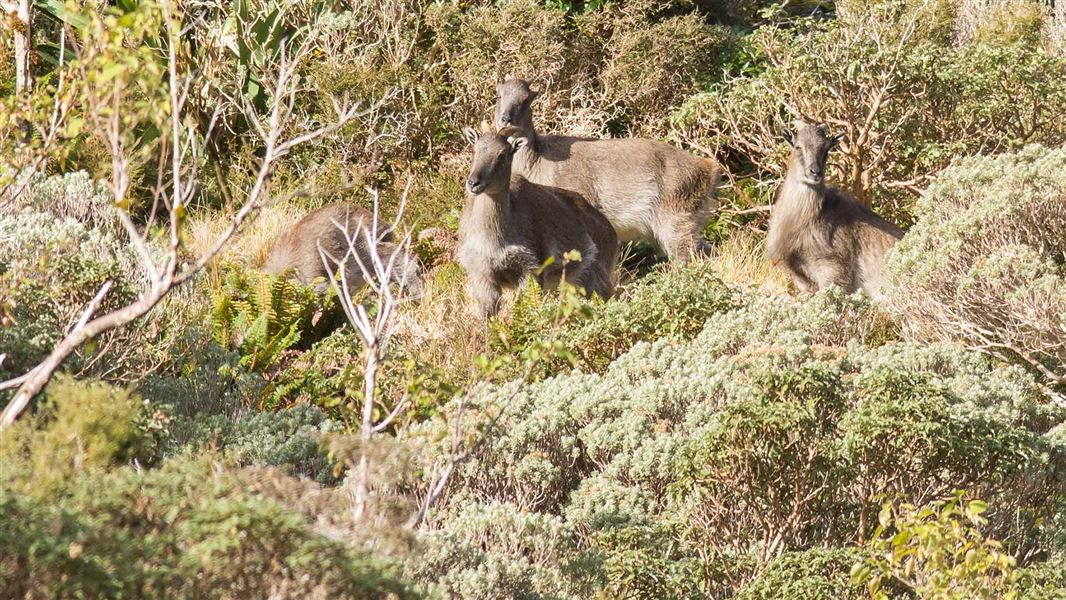Archived content: This media release was accurate on the date of publication.
Date: 10 May 2021
DOC’s Tahr Control Operational Plan for 2021/22 was developed during five months of engagement with tahr stakeholders including hunting and conservation groups. DOC received valuable contributions from stakeholders in written submissions and two meetings.
DOC Wild Animals Manager James Holborow says the new plan provides an exciting opportunity to explore greater hunter involvement in tahr management within a popular hunting area.
“We have started discussions with the Tahr Plan Implementation Liaison Group (TPILG) on what hunter-led management would look like for the tahr population within the South Rakaia/Rangitata Management Unit.
“This could involve hunters managing tahr populations as well as reporting on tahr numbers and the health of ecosystems. We’re excited to see what we can achieve by working together with the group on this opportunity.”
James Holborow says a survey undertaken in Autumn 2021 will provide valuable insights for the group to consider.
The survey will give detailed information on tahr numbers in the South Rakaia/Rangitata and the Gammack/Two Thumb management units, including the gender balance of the local tahr population.
“We have decided not to control tahr in the South Rakaia/Rangitata management unit over the next year, while we analyse the survey data from this popular hunting spot. The area is accessible by vehicle, has a range of huts available and is favoured by hunters for day hunts or longer trips. We look forward to seeing recreational and guided hunters play the major part in control efforts.”
The new Tahr Control Operational Plan also outlines how DOC will continue to work with recreational and commercial hunters to control tahr on public conservation land in other areas of the South Island.
“We’re still working towards achieving the goals of the Himalayan Thar Control Plan 1993. This year most of our control effort will shift to the West Coast, where high densities of tahr remain in some places. East of the alps, our work will focus on places which are difficult for ground hunters to access, but where there are high numbers of tahr.”
DOC will continue to target all tahr in Aoraki/Mount Cook and Westland Tai Poutini national parks, and outside the feral range. DOC will not target identifiable male tahr over the remaining 425,000 hectares of public conservation land inside the seven management units.
“We will continue to focus on targeting high tahr densities on the West Coast where hunter access is challenging, and hunters and other stakeholders have reported there are still large numbers of animals. We also plan to trial using professional ground hunters to search for and control tahr in forest areas where animals can be hard to spot from the air.
“This year we will be sharing maps showing identifiable male tahr observations, and spots where we have seen high tahr densities in recent surveys. Hunters will be able to find this information on our website and Facebook page to help plan their next hunting trip and contribute to tahr control.”
Around the midpoint of the tahr control programme, DOC and the Game Animal Council will review the work undertaken. DOC may then reallocate resources to other management areas to optimise control.
Hunters can expect to see control operations underway from early July. DOC will publish an update on the website when work in each area is complete for the season. DOC aims to carry out control as quickly and effectively as practical to minimise the likelihood of affecting hunters.
“We want hunters to have certainty they can hunt tahr in the east from early spring, knowing DOC’s control there is complete for the year.”
DOC’s research and monitoring programme is also continuing this year with several initiatives underway to learn more about the tahr population and ecosystems.
“Earlier this year we began remeasuring historic vegetation plots on the West Coast and this work will continue over the coming summer. We’re also planning to implement a new programme to look at vegetation condition at different tahr densities,” says James Holborow.
Background information
View the Tahr Control Operational Plan 2021/22 (PDF, 1,561K)
The specific timing of operations within each management unit are included in the operational plan.
More about tahr and tahr management
- The Himalayan Thar Control Plan 1993 (HTCP) is a statutory document made under section 5(1)(d) of the Wild Animal Control Act 1977.
- Native to India and Nepal, Himalayan tahr are large goat-like animals that were introduced to New Zealand’s South Island in 1904.
- As tahr have no natural predators in this country, their population can increase without regular control from DOC and hunters. Large groups can form and damage plants which provide vital food and shelter for native species.
- DOC’s annual Operational Plan identifies how it will implement the HTCP, which sets a maximum population of 10,000 tahr across 706,000 ha of private land, Crown pastoral leases and public conservation land within the tahr feral range.
- Each management unit has hours allocated where DOC will search and control high densities of tahr. If operators are not finding large groups, DOC will reprioritise its control effort elsewhere.
- Last year DOC and LINZ undertook a research project to learn more about tahr on Crown Pastoral Lease land. The results of this survey will be released in the next few months.
Contact
For media enquiries contact:
Email: media@doc.govt.nz
